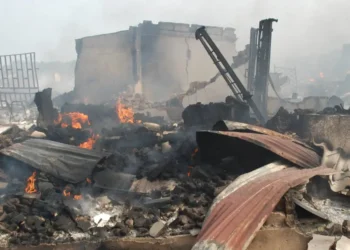More than 121 countries voted at the UN General Assembly in New York on Friday to adopt an Arab resolution calling for the war on Gaza to end and for humanitarian aid to be allowed to flow into the battered territory. Only 14 countries voted against it, one of which was the US.
An amendment to the resolution proposed by Canada, co-sponsored by the US and some European countries, that called for condemnation of Hamas failed to garner enough votes and was not adopted.
Before the vote, Pakistan’s permanent representative to the UN, Munir Akram, said it was “amazing” that his Canadian counterpart did not feel the need while condemning Hamas to condemn Israel, too, “for the enormity of the crimes it has committed in Gaza.” He added that “the Israeli occupation is the original sin behind this crisis and not the Oct. 7 attack.”

If Canada wants to be fair, he continued, then it must condemn both sides or name neither.
Riyad Mansour, Palestine’s permanent observer to the UN, thanked the 120 nations who voted in favor of the resolution, telling reporters that “there is still goodness in this world and we will never forget your position today.”
However, the resolution represents only “chapter one,” he added, and he vowed to continue “knocking every door” to stop the war against Gaza.
The Arab resolution, titled “Protection of Civilians and Upholding Legal and Humanitarian Obligations,” condemns all acts of violence targeting Palestinian or Israeli civilians. It
calls for an “immediate, durable and sustained humanitarian truce leading to a cessation of hostilities,” the “immediate and unconditional” release of all civilians who are being “illegally held captive,” and “the immediate, continuous, sufficient and unhindered” flow of life-saving aid to civilians throughout the Gaza Strip, including water, food, medical supplies, fuel and electricity.
It also “firmly rejects any attempts at the forced transfer of the Palestinian civilian population” and urges Israel, “the occupying power,” to rescind its evacuation order for Gazans in the north of the territory to relocate to the south.
After two weeks of almost continuous Israeli shelling, the UN has described the situation that more than 1.5 million Gazans are facing as “a catastrophe.” Much of the territory’s civilian infrastructure has been destroyed, including hospitals, schools, water and sanitation facilities, and about 40 percent of homes. Water supplies have all but run out, and there are reports that people have been forced to drink sewage water.
UN agencies have warned that very soon, mortality rates will “skyrocket due to disease outbreaks and lack of healthcare capacity.”
The UN resolution was sponsored by more than 47 countries, including Saudi Arabia, Oman, Qatar, Kuwait, Jordan, Iraq and Lebanon, along with Russia and a number of African and Latin American countries.
Beyond physical injuries, children in the Israel-Hamas war zone will have to contend with lasting emotional wounds
Experts say exposure to armed conflict can lead to attachment disorders, nightmares, flashbacks and persistent anxiety
LONDON: Unending waves of Israeli airstrikes on Gaza over the past fortnight have aggravated an already perilous situation for the enclave’s children, who have suffered for more than a decade with no end to the conflict in sight.
Health officials in the Gaza Strip say that more than 2,300 children have been killed in the war between Israel and Hamas that erupted following the Oct. 7 assault on southern Israel by the Palestinian militant group.
Some 40 percent of the embattled territory’s inhabitants are aged under 18, with UNICEF reporting that an average of 400 children have been killed or injured daily in the violence. Save the Children fears a further 870 remain trapped under rubble.
Despite the reopening of the Rafah border crossing between Egypt and Gaza on Friday and the delivery of dozens of trucks loaded with aid and medical supplies, the need for assistance remains paramount. (AFP)
Yet what sometimes goes forgotten is that beyond physical injuries, the children of the conflict zone have also had to contend with deep and lasting emotional wounds.
In a recent article, “Child casualties in Gaza ‘a growing stain on our collective conscience’,” UNICEF said that “almost every child in the Gaza Strip” has witnessed distressing events and trauma, with NPR noting that after the 2021 war, 91 percent of Gaza’s children had suffered post-traumatic stress.
“Children with conflict exposure have been found to have higher rates of anxiety, depression and psychosomatic complaints,” said Ayesha Kadir, a senior humanitarian health adviser at Save the Children. “(But) children do not express psychological distress in a single way. Some may act out, others may withdraw.
“They may act younger than their age, start bedwetting, have trouble sleeping, refuse to eat, or have internalizing effects such as stomach aches or headaches. Not all children who experience trauma are traumatized. However, experience of conflict is a form of toxic stress, which has both physical and psychological harms.”
Furthermore, a report produced last year by Save the Children found that more than half of the children in Gaza had suicidal thoughts, with three out of five engaging in self-harm. And with the latest surge in violence, it is not only the children of Gaza who have become direct victims.
UNICEF notes that a reported 30 children were killed in the Oct. 7 Hamas attacks on Israel, while dozens more are either themselves being held hostage within Gaza or have family in captivity.









